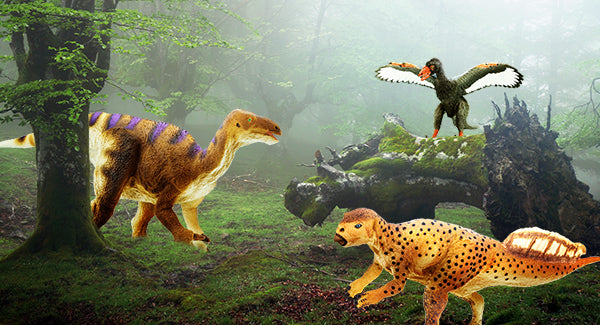
Which Dinosaurs Would Have Made the Best Pets?
Dinos are a big deal around here! We're often asked which dinosaurs from our Prehistoric World Collection would have made the best pets!? Well, we've got a few answers for you!
You might wonder: What would it be like to ride a Triceratops? Could I outrun a T-Rex if it started chasing me? And wouldn’t it be really cool to have a dinosaur as a pet? Well, in a completely real situation, it would probably be pretty irresponsible to have a dinosaur as a pet. Many of them are way too big and full of sharp teeth and claws! If movies have taught us anything, it’s that keeping a bunch of dinosaurs penned up is probably a bad idea. But since we’re imagining it, it might be fun to think about which dinosaurs you’d want to curl up at the foot of your bed at night, like a loyal puppy.
Archaeopteryx
Archaeopteryx was a small bird-like dinosaur, and one of the first dinos to be discovered with feathers. It was about the size and shape of a modern day parrot, just with more teeth and claws. So, it stands to reason that Archaeopteryx might be a good candidate for a prehistoric pet, since lots of people keep present day birds as pets.
Archaeopteryx was important in helping scientists establish the link between birds and dinosaurs, which reminds us – anyone who has a bird for a pet today really does have a pet dinosaur, since birds and dinosaurs are one and the same! Many dinosaurs became extinct at the end of the Cretaceous Period around 66 million years ago, but those that survived evolved into what we know today as birds!
While it might be tempting to have a pet Archaeopteryx, it’s worth noting that pet birds like parrots require a lot of attention and care, and like any pet, they come with lots of responsibilities. Archaeopteryx would likely not be any different in this respect. And you probably couldn’t teach it to talk, either.
Microraptor
Along similar lines, the raven-sized Microraptor might also have made a decent pet. It was a very bird-like dinosaur, with wing-like feathers not only on its arms, but on its legs as well. It also had a lot of features in common with its much larger relatives like Velociraptor, including a mouth full of teeth and a large, curved claw on each foot.
However, given its small size, it could probably have been somewhat tamed with the proper care and instruction. Just make sure you steer clear of that toe claw!
Iguanodon
Don’t let the size scare you away! While Iguanodon could grow up to 30 feet long, it was also thought to be a peaceful plant eater. You might not want to go wrangle yourself a full grown Iguanodon as a pet, but if you raised one from a baby, it might grow up to be a loyal companion. Just think of it like a horse or a cow –just extra large.
One thing you’ll want to look out for is the Iguanodon’s unique thumb spike. Originally thought to be a horn on the dinosaur’s nose, you’d be wise not to get too close to this pointy claw. But if you had ample space in your backyard, and plenty of plants to much, Iguanodon could prove to be a perfect prehistoric pal.
Psittacosaurus
If Iguanodon is a bit too big for your tastes, consider the Psittacosaurus instead. Growing to a much more manageable 6.5 feet in length, this plant-eater had a head resembling a parrot and a unique brush-like row of quills along the back of its tail.
You wouldn’t know by looking at it, but Psittacosaurus was closely related to the horned dinosaurs, including Triceratops and Styracosaurus. Psittacosaurus, thankfully, was much smaller and didn’t have a face covered in horns like its cousins.
Its parrot-like beak could probably inflict a nasty bite, so you’d want to keep your fingers away from its mouth. But, if you were to keep your Psittacosaurus content with a belly full of yummy plants, it’d probably make a pretty decent pet, sort of a cross between a dog and a parrot. Psittacosaurus is very well understood by scientists, who even know that its coloration featured spotted patterns…meaning you could even name your pet Psittacosaurus “Spot”!
Protoceratops
Like Psittacosaurus, Protoceratops is a relative of larger horned dinosaurs like Triceratops. Unlike Psittacosaurus, it pretty closely resembled its larger cousins, walking on four legs instead of two, and sporting a bony frill that protected its neck. It lacked the horns of its relatives, but retained its sharp beak for chomping on plants.
Protoceratops grew to about six feet long, making it just a bit smaller than Psittacosaurus. Where Psittacosaurus was mostly slender, Protoceratops was more robust and portly. It would be easy to imagine Protoceratops trotting along on the end of a leash, like a prehistoric puppy. But as with Psittacosaurus, you’d want to make sure your Protoceratops had enough greens to eat, and steer clear of that sharp beak!
At this time, the only dinosaurs any of us can keep as pets are of the bird variety, and those involve quite a bit of responsibility. But it’s fun to imagine which dinosaurs might be fun to take for a walk or have sitting on your shoulder, isn’t it? Sadly, it’s not possible, at least not yet…but who knows what the future might hold?





 Facebook
Facebook
 Twitter
Twitter
 Instagram
Instagram
